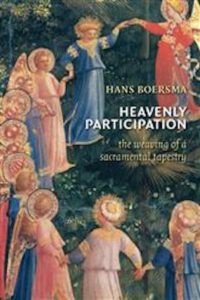
Heavenly Participation: The Weaving of a Sacramental Tapestry
In Heavenly Participation, Hans Boersma, one of today’s leading evangelical theologians (and, in the interests of full disclosure, a friend to this reviewer), provides an accessible and compelling distillation of his recent project. The argument should be especially interesting for readers of this journal, since Boersma’s book is perhaps the most theologically responsible version of a long-standing trend within Christian higher education: appealing to a “sacramental” worldview. Within literary and artistic circles in particular, this language—along with its frequent sibling, an “incarnational” approach to culture and/or ministry—galvanizes teachers and students to affirm the goodness of God’s creation and to resist the prior evangelical tendency toward unhealthy dualisms. Including but also transcending these concerns, Boersma’s account offers historical and ontological underpinnings for an appealing “sacramental” tapestry.
The book unfolds in two parts, intentionally paralleling the exitus–reditus, going out and returning, scheme that characterized the classic Christian-Platonist synthesis, according to which humanity participates in the shape of Christ’s life. Thus Part 1 narrates “The Fraying Tapestry” before Part 2 describes how to enable “Reconnecting the Threads.” An Epilogue concludes this call for the “Christ-Centered Participation” of humanity and even all creation in the fellowship of the Triune God. Along the way, Boersma appreciatively expounds the thought of Nouvelle Théologie Roman Catholics in twentieth-century France, such as Yves Congar, Henri de Lubac, and others, who were known for ressourcement. Opposing the dominant, scholastic Neo-Thomism of their day, which overemphasized and ossified the philosophical components of Thomas Aquinas’s thought, the ressourcement theologians called for recovering the full range and depth of classic Christian texts and practices.
First in the narration of Part One, Boersma sketches the contours of the ontology for which Nouvelle Théologie calls. A sacramental focus stems from Christian conviction concerning the real presence of Christ, the mysterious reality behind empirical appearances. The presence of Christ is not merely symbolic, utterly distinct from that which appears, but rather sacramental, so that the appearance participates in the reality itself. This is true of all creaturely things, which we are called to “use” rather than “enjoy” (so Augustine). The created order exists not for its own sake, but as a proximate means of enjoying participation in God. Hence Boersma does not simply concede, but instead celebrates, the classic Christian synthesis with carefully chosen elements of Platonism.
Second, Boersma anchors creaturely participation in God Christologically—sketching such a view from Irenaeus, Athanasius, and Gregory of Nyssa. Third, though, comes the medieval unraveling of the tapestry culminating, finally, in the sixteenth century when nature and the supernatural separate. According to de Lubac, the Catholic Counter Reformation overreacted to Protestants by introducing a notion of “pure nature,” the state of humanity before the fall and apart from grace. Meanwhile the idea that people naturally desire the vision of God fell under suspicion. The result of this new Catholic thought was an increasingly disenchanted cosmos, in which creation is not necessarily ordered to the Creator.
The fifth chapter critiques younger evangelicals attempting to reweave the “sacramental” tapestry in misguided ways. Boersma acknowledges the perennial need for reformation but insists also that the Protestant Reformation must be viewed in tragic terms, since it tore apart the church’s sacramental unity. Neither Luther nor Calvin held a simply univocal view of language, or voluntarist freedom, or nominalism either, but still there were marks of these tragic influences. Today certain “postmodern” evangelicals latch onto the wrong elements of the Reformation for moving forward—moving against reason, traditional morality, and church authority. Furthermore, optimism over Catholic-Evangelical rapprochement is misplaced, according to Boersma, given lagging momentum for Evangelicals and Catholics Together.
The implications drawn in Part Two must be summarized more briefly, even as the rest of this review tries to address them. Boersma would reconnect threads of the “sacramental” tapestry in order to configure “Eucharist as Sacramental Meal” (chapter 6); “Tradition as Sacramental Time” (chapter 7); “Biblical Interpretation as Sacramental Practice” (chapter 8); “Truth as Sacramental Reality” (chapter 9); and “Theology as Sacramental Discipline” (chapter 10). There is much wisdom in each of these elements; in fact, we should affirm most or all of what Boersma aims to promote in each case. But the question is whether the historical and ontological threads of this winsome theology fully hold together using “sacramental” language for the cosmos.
Among fraying historical threads on which to pull is selective narration. This is somewhat inevitable given the volume’s size; still, the Great Schism between the Eastern and Western churches makes nary an appearance, apart from a side note regarding complementary resources to be found in Orthodoxy, which never abandoned the “sacramental” worldview. One wonders accordingly about politics, churchly and otherwise—about how integral various claims to be the true church were to the “sacramental” vision, and how integral various church-state syntheses were within the tapestry itself. Why, to be blunt, remain Protestant? Apparently because Catholicism equally contributed to the tapestry’s unraveling. But why not Orthodoxy, then? William Abraham’s canonical theism offers a seemingly compatible narrative, albeit with an earlier point of decline in the Great Schism—thus pointing eastward. Boersma needs to address such questions, at least briefly.
An even broader issue is the propriety of grand narratives in the first place. What would a skilled historian, attentive to both intellectual and social/institutional factors, make of Boersma’s decline narrative? Such disciplinary integration need not denigrate de Lubac’s care with sources or prevent theologians from making generalizations; probably we must defend the right to learn from history in ways that make specialists nervous. Yet, to this reviewer’s knowledge, woe-is-nominalism (and so forth) narratives never consider adequately the panoply of factors that first prompted such intellectual moves. In other words, if the tapestry were so seamlessly wondrous, whence came its unraveling? Might a sympathetic, contextual account of nominalism and related intellectual developments lead theology somewhere besides the clutches of modern secularism?
Moving beyond initially historical concerns toward more directly ontological or dogmatic questions, the most tantalizing thread involves the propriety of “sacramental” language for ontology as such. We should share Boersma’s concern for greater attention to heavenly realities precisely in order to preserve our commitment to earthly goodness. The recent evangelical scorn for heaven relative to earthly new creation is an understandable overreaction against former dualisms. But now the overcorrection needs correction. And, to be sure, the language of mystery, participation, and sacrament has its vital place in Christian theology. One can enthusiastically endorse recovering a sense of divine mystery regarding the Eucharist, tradition, Scripture, and indeed all of God’s creatures. At that point, though, more ontological detail about such participation—or at least clarity about what this would not mean—is required.
Yet the paramount linguistic question involves “sacramental” as an adjective. Might one acknowledge the grace involved in creation more faithfully using concepts from Boersma’s Reformed tradition (for example), such as covenant and fellowship, without risking the simultaneous anthropological alienation from and accommodation to modern culture that the Nouvelle Théologie could put into play? Broadly compatible approaches to the modern loss of theological nerve, from diverse sources—such as (in addition to Abraham) Michael Buckley, William Placher, and Kathryn Tanner—suggest that Boersma’s project is full of potential insight. Yet one could agree that the Reformation had its tragic side while also maintaining that Luther and Calvin were on essentially the right track, and that the insights of ressourcement thinkers ought to supplement and reshape Protestant thought instead of the other way around. At one point, Boersma virtually equates appeal to “analogy” with “participation” and “sacramental” language; however, the Reformed tradition likewise affirms analogy and develops a particularly Christological version thereof, while orienting participation and sacraments relationally toward covenant fellowship. (Indeed, the work of Todd Billings points to Calvin’s rich theology of participation.) In short, at some junctures, alternative readings of either Protestant or Catholic positions are worth noting.
Boersma’s presentation of de Lubac’s axiom, “The Eucharist makes the church,” is in many respects wonderful. However, precisely because of “participation” language regarding the Lord’s Supper in 1 Corinthians 10, we must be careful not to overinflate its application elsewhere. To some degree, application of “sacrament” to baptism and the Eucharist is (providentially) an accident of history rather than scriptural usage; the Bible uses the equivalent terminology of “mystery” in other senses. The mysterious revelation formerly hidden is temporally new (accomplished in Christ) and ethnically expansive (incorporating the Gentiles), rather than visually unfolding (a spiritual reality behind the literal) or spatially uplifting (from earth to heaven). Though, as noted above, a broad sense of mystery pertains appropriately to God’s work in the world, the term “sacrament” has become attached to a specific set of churchly practices wherein God works by particular means of grace. According to Douglas Farrow and others, the ascension of Jesus further circumscribes the claims we should make about Christ’s presence in the church here and now, given all-too-frequent ecclesiastical tendencies toward political and theological self-inflation. The sacraments are particular mysteries regarding God’s presence in the world, and even the church’s participation remains mysterious, lest she be tempted simply to equate herself or any other creaturely reality with the locus of God’s kingdom.
For most Protestants, moreover, baptism and Eucharist primarily or even exclusively share the biblical domain named by this category: they are divinely ordained rites of personal participation in the communion of Christ’s resurrected body. Distinctively proclaiming Christ’s death, baptism initiates, and the Eucharist maintains, this participation. Thereby the church confesses her union with Jesus’s past work, her present unity under his inaugurated lordship, and her future reunion with the Head who now remains partially absent from his body. For exactly the kinds of reasons to which Boersma points from 1 Corinthians 10, a truly “sacramental” view might maintain that the language of sacrament must be reserved for particular rites. Does the Eucharist imply that as humans are sanctified they sanctify the use of creaturely goods, so that by this self-offering they honor the Creator? Does this have implications for one’s worldview? Certainly. But the expansion of “sacramental” and “incarnational” linguistic territory threatens to undermine the very Christ-centeredness for which Boersma appeals. The Incarnation is about more than a principle of affirming embodiment. The sacraments, while perhaps having more direct implications for the blessing of creaturely gifts before God, nevertheless also retain specific senses of divine mystery. Otherwise there is a danger that, if everything becomes “sacramental,” then nothing is sacred.
Even so, Heavenly Participation offers an attractively written, bracingly argued, clearly presented account of how evangelical Protestants might appropriate an important strand of modern Catholic thought—not to mention the classic Christian tradition. Its author is a wise participant-observer of contemporary Evangelicalism, and the intricate detail of the book’s tapestry makes for a winsome display. The questions at stake deserve more time and space than we have here, and I look forward to ongoing dialogue. “Almost thou persuadest me…”; yet, for the moment, although sharing most of the author’s aims and many of the book’s affirmations, I remain unable to adopt its core historical and linguistic framework.























